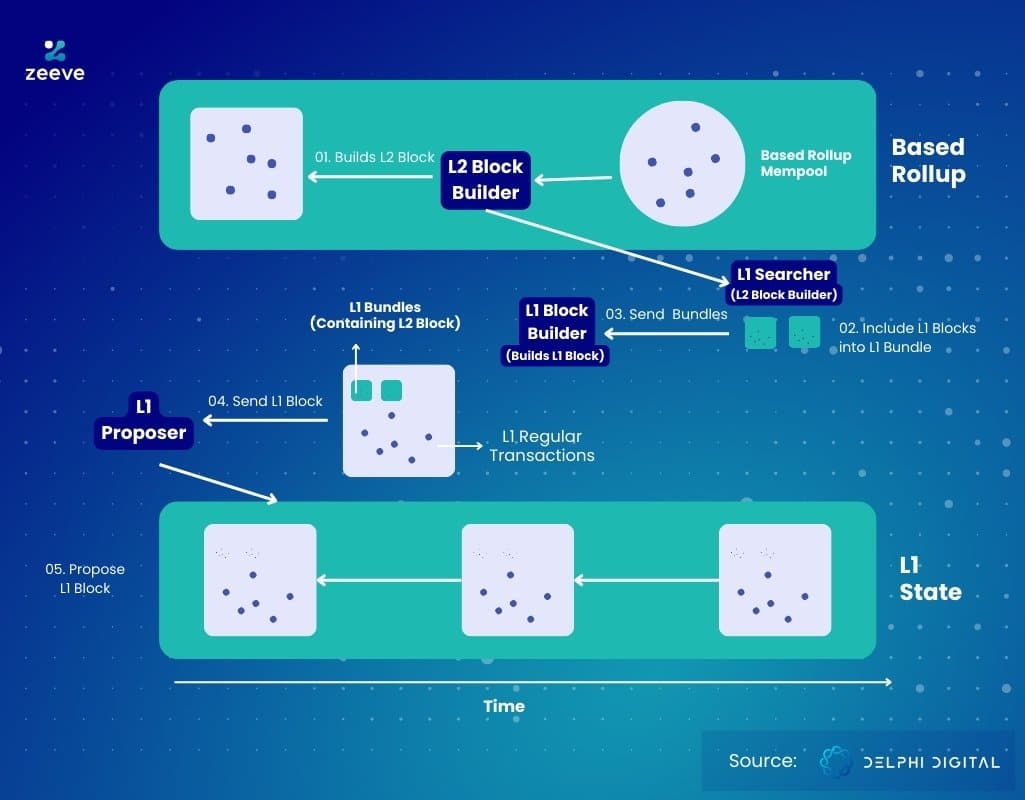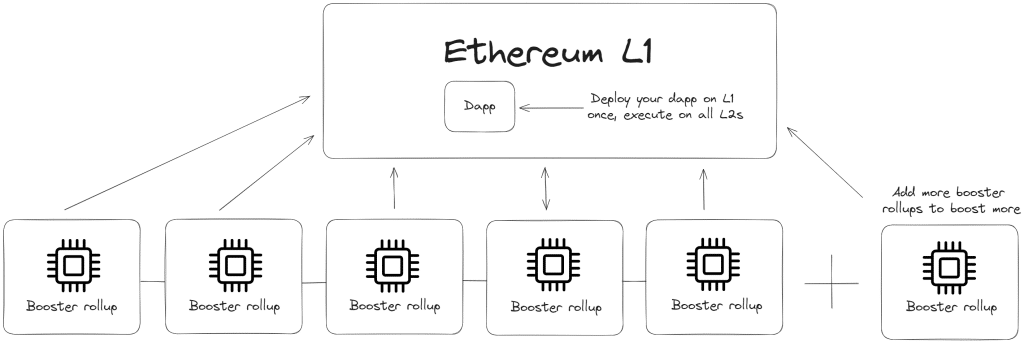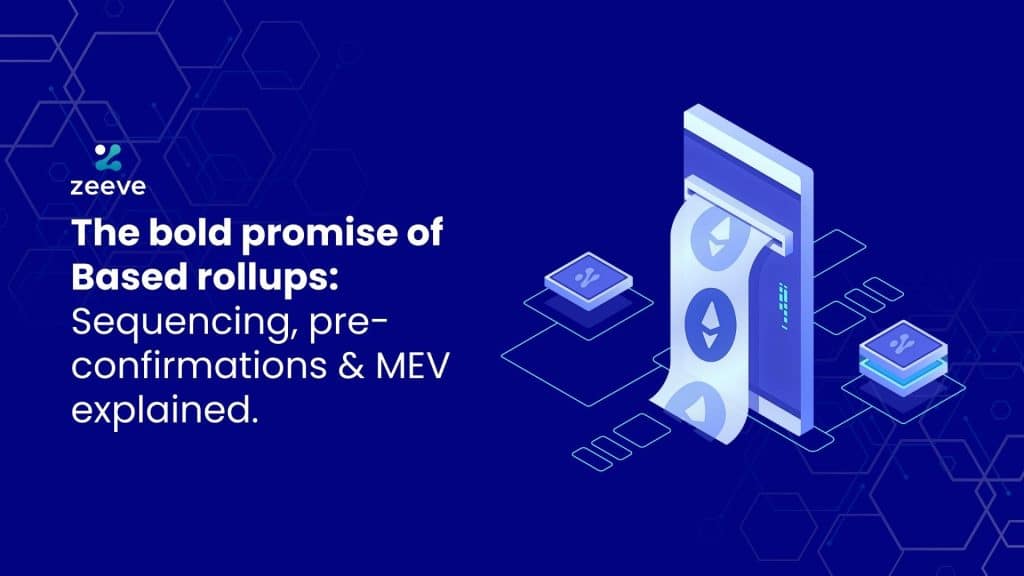As of today, most rollups use a centralized sequencer since it matches their key L2 requirements like fast finality, easy access, and cheaper transactions. Because centralization may sometimes lead to issues like monopoly on MEV & gas price, unfair transaction censorship, and other network effects– decentralized shared sequencers came into the picture to solve these challenges. Now that L2 rollups seek even higher decentralization and better Ethereum (L1) alignment, ‘Based Rollup’s have been introduced. The idea of based rollup is quite a new and unique concept, and therefore, only a few protocols like Taiko are offering it. However, understanding this concept is important for web3 enthusiasts, especially L2 projects and enterprises.
Hence, this article dives deeper into the core concept of based rollups to highlight its significance, working mechanism, and overall impact on the Layer2 rollup ecosystem.
What are based rollups?
Based rollups, also known as ‘L1-sequenced’ rollups, refers to the Layer2 rollups where sequencing is driven by Layer1 Ethereum. Meaning that based rollups can leverage the validator set of underlying L1 for fair sequencing rather than setting up and managing their own dedicated sequencer set. This allows block proposers (who collect bundles on L2 into L2 block) on L1 to collaborate with block builders (who construct blocks on L1) to add the next rollup block as the next L1 block in a fully permissionless manner.
The based rollups we see today have been iterated multiple times since the original idea coined by Vitalik Buterin in 2021 as ‘Total Anarchy’, which implies that anyone can submit a transaction batch at any given time. The exact term ‘Based Rollup’ and a formal definition were brought out by Justin Drake, Ethereum foundation’s researcher, in 2023. Justin Drake essentially focused on aligning L2 rollups as close as possible to Ethereum, allowing L2 rollups to get Ethereum liveliness, decentralization, and sovereignty.
Current rollups like Arbitrum or Zk Stack could transition to based rollups. All they need is to implement a based rollup into their current sequencer system and start utilizing the L1 sequencer to send transactions directly to L1 proposers. However, because execution is still done on rollup, based rollups include all the necessary fault & Zk proofs to confirm the output.
For a better understanding, let’s see the based rollup’s architecture. As we know, a rollup consists of 4 main layers– settlement layer, DA or data availability layer, consensus layer, and execution layer. These same layers form based rollups, only the approach changes a little.
- Settlement layer- Ethereum as its settlement layer, hence their proof is posted on Ethereum and is accessible to everyone for verification.
- DA layer- Rollups have the choice to choose either Ethereum acts or off-chain DA layer like Celestia or NEAR DA as their DA layer.
- Consensus layer- Based rollups do not use an independent consensus layer, instead it relies on Layer1 for consensus and transaction ordering.
- Execution layer- Transactions in Based rollups are executed off-chain on its own execution layer.
Also, here’s a graphical representation of Based rollup’s architecture:

How based rollups work?
Based rollups use Ethereum’s sequencer to integrate transactions directly on Layer1 blocks leveraging its existing validators. Here’s a technical breakdown of how based rollups operators on a high level:
- Layer1 block searchers or L2 block builders can pick transactions from mempool, create bundles, and send them to block proposers.
- The block proposer includes multiple L2 blocks into L1 bundles.
- Layer1 block builder builds L1 block. Here, the block contains regular L1 transactions plus L1 bundles that contain Layer2 blocks.
- Then, the block builder sends the L1 block to the Layer1 proposer.
- L1 proposer sends proposed L1 block to be included in the Layer1 state.

What problems Based Rollups aims to solve: Its main Advantages
Now, let’s discuss the key advantages of based rollups that also solves some of the challenges of L2 rollups:
Ethereum (L1) Alignment
Based rollup uses L1-based sequencer and hence they offer L1-level liveliness. Due to this, based rollups can offer:
- Shorter timeout period: Based rollups leverages advanced settlement guarantees, enabling quick timeout periods. A based rollup typically can offer 100ms transactions.
- MEV censorship: By ensuring better decentralization, based sequencer tackles the risks of toxic MEV or transactions censorship monopoly.
- Attacks & network risks: L1-equivalent also liveliness also protects L2 rollups against risks like 51% attack.
Btw, these benefits highly come from decentralization, which is already catered through shared decentralized sequencer. Only the difference is, shared sequencers are not necessarily based on Ethereum, it can be a separate set of nodes. Meaning that, based rollups are aligned towards Ethereum.
MEV Capture for decentralization
Based rollups claim to inherit decentralization from Ethereum to organically reuse the searcher-builder-proposer mechanism. The searchers and block builders on L1 are accountable to perform MEV extraction through including rollup blocks in their L1 bundles and blocks. To incentivize these L1 actors, based sequencing captures MEV from L2 and strengthens the L1’s economic security. On the other hand, L2s sacrifice MEV for the sake of decentralization, security, and Ethereum alignment.
However, Justin Drake suggests that transition to based rollups won’t create revenue scarcity on L2. He equals MEV to congestion + contention. Here, congestion includes using EIP-1559 for base fee and contention is for bad MEV extraction such as sandwich or front-running attacks. At present, 80% of MEV on Ethereum consist of congestion and 20% is ‘bad MEV’. L2 rollups can apply this same logic, a limited MEV will go to L1 and substantial revenue flow can be maintained on L2. Also, restaking is one of the other solid options to get revenue on L2 that we will discuss in a while.
Simplicity
Based rollups are simple to implement and maintain in the long run. This is possible because L1-sequenced rollups reuse the Ethereum infrastructure Instead of building their very own sequencer infra from scratch. Further, based sequencers do not need any signature verification on L1 or L2, no escape hatch, or additional PoS consensus. All these can reduce the cost on L2s notably.
Fast finality with ‘Pre-confirmation’:
Justin Drake proposed the idea of ‘pre-confirmation’ in 2023. As discussed, Ethereum is congested and has limited block time, which will obviously impact the performance on based sequencers. But, based rollups can still maintain fast finality using the ‘Pre-confirmation’ mechanism. Here, a subset of Ethereum’s validator commit to pre-confirmation through re-staking and agreeing to the below two slashing conditions:
- Liveliness fault- sequencer’s slot is missing.
- Safety faults- sequencer’s slot is not missing.
These validators guarantee that they will include based rollup blocks in Layer1 blocks that will be proposed in future. But, this is possible only in cases when validators have the information about at least 32 blocks as to which proposer is assigned to which block.
Note that pre-confirmation not only boosts confirmation, but it also unlocks a great revenue source for L2 due with re-staking. This way, L2 can somehow compensate for the MEV flowing to L1.
Cost optimization:
Cost on based rollups can be less because it eliminates the need of setting up a sequencer ecosystem from scratch and its maintenance. Also, there is no gas overhead as signature verifications are not required. All this allows for reduced cost, which contributes to accelerated time-to-market for L2 rollups.
Cross-rollup communication:
Similar to shared decentralized sequencer, based rollups can also have a built-in mirror to Layer1 to enable seamless communication between Ethereum and various L2 rollups. For this, L2s probably need to deploy a smart contract on Layer1 (main chain) and provide smart contract instances on all the adjacent L2s. For example, a token contract on L1 will allow seamless token transfer across Ethereum and L2s. Going forward, more L2s can be added as required.
Challenges facing Based Rollups
Based rollups come with certain tradeoffs, which can impact its practical application. Let’s check out the main challenges:
- Lack of MEV income: In based rollups, the revenue generated from MEV flows to L1, where it is utilized to incentivise L1 proposers for including L2 rollup blocks on L1. It means, L2’s revenue will stay limited to base or congestion fees.
- Limited sequencing & slow finality: Delegation of sequencing tasks to Layer1 leads to flexibility issues such as block time stay limited to Ethereum’s block time, proving will be slower, and congestion will be higher.
- Risks of public mempool: Based rollups implements a public mempool (unlike private mempool in centralized sequencers) to Layer2s. Openness means the mempool is exposed to security risks such as sandwich and frontrunning attacks.
Who all are offering Based Rollups?
The concept of based rollups is relatively new in the web3 space, and therefore its practical application still awaits. However, few players like Taiko and Espresso offer based sequencers for Layer2 rollups.
Taiko claims to be the first protocol to offer based rollups and the protocol is creating buzz with their latest ‘Based Booster rollups’ or BBR. The idea of booster rollup is to amplify the existing capabilities of Taiko’s contestable rollups and offer a robust system that allow L2 dApps to scale endlessly and automatically without any heavy lifting of infra optimization, devs work, cost, or redeployment. It’s like deploying your dApp once on Ethereum and executing it on all the connected L2s and whenever there’s a need for scaling, you can add more booster rollups.

Source: Taiko
Also, there is Espresso offering Based sequencing. This allows L2 rollups to transfer sequencing rights to the L1 block proposer and get their smart contract updated without any help from centralized, 3rd party sequencers. Based Espresso offers all the benefits that an ideal based rollup protocol should offer, including L1 liveliness, L1 composability, fast confirmations, and MEV distribution. You learn in-depth info about Based Espresso here.
Bottom Line
In conclusion, based rollups aim to add scalability and decentralization on L2s through Ethereum -based sequencing. However, this concept is still new and debatable for many. For now, L2 rollups are more into centralized and shared decentralized sequencers. And, therefore, the adoption of based sequencers may not be fast-paced for some time. Now that Taiko is going to launch mainnet for its Based Booster rollups, we wait to see more innovation in the BR ecosystem and L2s’ take on it. And, if you have any queries related to rollups, you can connect with the experts at Zeeve. From project consultation to initial discussion, Zeeve handles everything with equal attention.






















